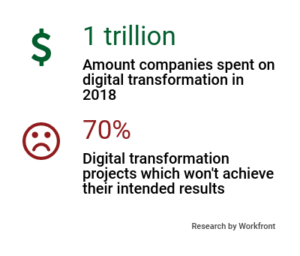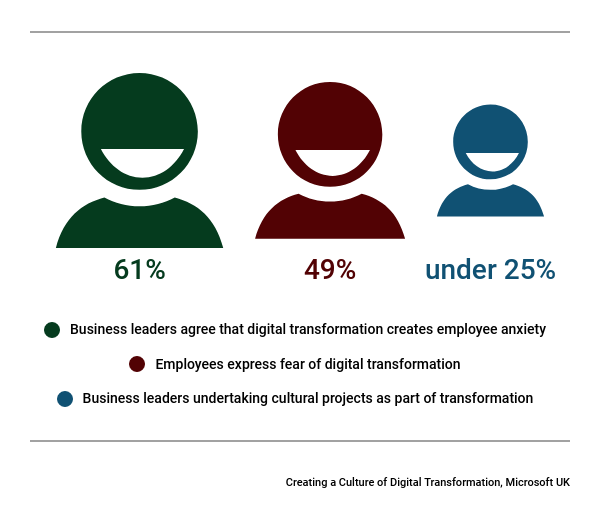Only eight per cent of CEOs believe their business model will survive the current levels of large-scale digital disruption.
That’s according to research by work management platform, Workfront. Chief executive Alex Shootman knows the pressure businesses are under, “and yet there is still a lot of confusion as to what digital transformation actually means.”
This guide will explain how to set goals and lay the groundwork for digital transformation, cover four possible transformation methods, explore the impact such projects have on company culture, and establish what can be learnt from high-profile digital transformation failures.
- Setting your digital transformation goals
- Five ways to get ready for digital transformation
- Four methods of digital transformation
- The impact of digital transformation on company culture
- Four digital transformation failures and what to learn from them
Ultimately, those that aren’t on a digital transformation journey risk losing revenue, market share and the best employees
- Rob Lamb, CTO of UK & Ireland, Dell EMC
Setting your digital transformation goals
Before beginning digital transformation, organisations must identify their end goal. Beyond the clear need to remain competitive and improve market share, some companies may choose to digitally transform so they can serve their customers better, by introducing new products or services. Others may digitise to streamline internal processes or free up their employees’ time to do less mundane tasks. Take the time to outline these desired outcomes, as this will define the sort of digital strategy you should be creating.
 Five ways to get ready for digital transformation
Five ways to get ready for digital transformation
For digital transformation to succeed it is vital to understand what can go wrong and to have a solid process in place. Mr Shootman has worked with hundreds of companies undergoing digital transformation and identified five steps to take before beginning.
1. Go slow to go fast.
For digital transformation to be successful, there will be a number of roles from many different departments collaborating. According to Mr Shootman, in the average organisation 84 per cent of workers do not know what it is their colleagues do. For digital transformation projects to succeed - this has to change. Take the time to make sure that all involved understand what everyone else is occupied with.
2. Make sure the technology is user-friendly.
Technology sits at the heart of any digital transformation initiative, be it new project management software to use internally or specific digital products created to appeal to new customers. Either way, the reality is clear: if it is difficult to use, people will not use it. This is particularly important from a talent management standpoint. When an increasingly large percentage of the workforce are digital natives, in-house technology must be intuitive, or this talent will simply go elsewhere.
There isn’t one approach that is the golden ticket to digital transformation success, but there are many ways to ensure you get the most out of the process
- Duncan Tait, CEO of Fujitsu EMEIA
3. Clearly articulate the “why”.
This is one of the most important elements of digital transformation: transparency. Everyone involved needs to understand the reasons behind such a huge project. “You’re asking people to change,” explains Mr Shootman, “if they haven’t bought into the why, it’s not going to happen.” Those at the top have to take the time to make sure the company is bought in - from board members to interns - or risk jeopardising company culture, and the long-term success of the project.
4. Shrink the change, shape the path.
This expression, coined by Chip and Dan Heath in their book Switch, illustrates the most effective way to approach a large-scale project such as digital transformation. Just as charities ‘shrink’ what they are asking of you (“just £1 a day could make all the difference”), so is it easier to broach a big project by cutting it down into smaller steps. Once you have shrunk it into steps, shape the path by identifying where each step should go in the process.
 5. Focus on best next actions.
5. Focus on best next actions.
“Imagine we are trying to cross a lake in a boat,” says Mr Shootman, “most people want to treat digital transformation like it’s a power boat, but it’s a sailboat, our progress will be serpentine.” When the maltese national airline, Air Malta, underwent digital transformation, they detailed a five-year plan. Years one and two prioritised revenue-generating activities, year three efficiency and optimisation, year four innovation, and year five will be spent consolidating all new tech and platforms. Along the way, old initiatives have been revisited, reworked, or jettisoned, as required. Identify a path to follow, but be prepared for deviations along the way.

Microsoft Creative Spaces
Four methods of digital transformation
“It would be trite to say ‘such and such is the best method of digital transformation’”, says Clare Barclay, chief operating officer of Microsoft UK, “you have to look at what the scenario is for the organisation in question.”
Once you have established your goals, and laid the foundations of your digital strategy, you must assess your organisation’s capabilities to select the best possible method for your digital transformation project.
1. Strategic partnerships
“Beginning the initiative, we really understood our limitations - this was crucial” explains Alan Talbot, chief information officer of Air Malta. Having identified the technical areas where they were not equipped, the airline chose to bring on board two hybrid integration and connectivity partners, MuleSoft and Ricston. Locally-based Ricston actually came and worked at the Air Malta headquarters throughout the process, so they could fully understand the organisation’s needs. “The fact that we could augment our team with these experts, and have their presence here on our premises, relating with the rest of our team, that was significant, because they could savour and understand what working for an airline is really like.”
2. Digital innovation lab
One possible way to explore new technologies is to trial your digital strategy (or parts of it) in a digital garage or innovation lab. This allows companies to innovate and test theories without disrupting the day-to-day running of the organisation. Car manufacturer Porsche has created the Porsche Digital Lab to test artificial intelligence, blockchain and the internet of things, with a view to improving both the driving experience in their vehicles and working conditions for their employees. Likewise, IT provider Fujitsu have established a number of Digital Transformation Centres across the globe to act as innovation hubs where their customers can come to ask questions about new digital tech.
What is driving digital transformation? Companies who desire to be more relevant to their customer
- Alex Shootman, CEO of Workfront
3. Dedicated change teams
A third possible method for enacting your digital transformation is to establish a dedicated change team - or a number of change agents - within the organisation. Organisations can choose to hire outside consultants, or identify natural innovators from within the ranks. These change agents work together to drive the digital strategy, and are responsible for going into each team or department to lead specific change projects. “One thing I would advocate,” says Ms Barclay, “is that these change agents are people who consider this their full-time day job, rather than trying to carve the role out of someone else’s already very busy day.”
4. Top-down
Many organisations may embark on a digital transformation project at the behest of the board or senior management. In some situations this makes the CEO the driving force behind the digital transformation project. Such was the case with Louise O’Shea, chief executive officer of price comparison website confused.com. With Ms O’Shea at the helm, the company decided to break their business model and start again, using artificial intelligence and automation. Most importantly, Ms O’Shea initiated the creation of an internal school for technology, to teach employees about the new technology coming in and reskilling them for the new roles they were to occupy.
Creating dedicated project teams or launching innovation labs are certainly options, but real success comes from creating an internal cultural mind-set that everyone has a part to play, from the rank-and-file employee to the board
- Rob Lamb, CTO of UK & Ireland, Dell EMC
The impact of digital transformation on company culture
In beginning their digital transformation, Confused.com understood the key element which can make or break a digital transformation initiative: company culture.
The most common employee reaction to a digital transformation project is fear. Even at tech company, Microsoft, digital transformation was met with a certain trepidation. “A lot of people still wanted to know “what does this mean for my job/status/colleagues? Will I get value/purpose/worth from the kind of work I do?’” says Ms Barclay.
At AirMalta, transformation had to occur very rapidly, to keep the airline operational, and this speed turned out to be a positive factor in terms of company culture. “Us being human, there is always the fear of the dark, and of the unknown. We couldn’t, however, adopt a less steep incline in terms of transformation. We had to be totally radical. I think that shock to the system proved to be unexpectedly helpful.” The result was that in just 11 weeks, the airline had the capability to integrate with a third party - something totally unheard of previously. This integration meant being able to release tickets and flight routes to Ryanair’s website, which gets one million hits a day.
In the face of this success, skepticism and fear quickly became admiration, but for organisations where this speed is neither possible nor desirable, it is important to have a cultural change programme to accompany the digital transformation project. “You have to think about how people can embrace the journey that they are on, and recognise that if people are more risk averse, that’s not something you roll your eyes at” says Ms Barclay. “You have to think about how to create a programme to help them and give them a voice.”
A digital first workplace frees up employees to be more creative, cooperative and innovative
- Duncan Tait, CEO of Fujitsu EMEIA
Communication is key in digital transformation. For it to succeed staff must be on board and - if possible - even excited about the new possibilities for the organisation. Ms Barclay suggests identifying both natural change embracers and naysayers within your organisation and making sure their feedback is heard and acted on. “You need people that are the life and soul of that group so you can seek to understand the change they’re going through.”
As well as improving internal processes and employee productivity, digital transformation even plays a role in boosting diversity and inclusion within an organisation. “Technology solutions can help people communicate better through the use of translation software, and it can also provide support for deaf people and people with autism.” explains Fujitsu’s Mr Tait. “Typically, there would have been multiple barriers for these people entering the workforce, but technology can dismantle them, and allow businesses to find new employees in a much wider and more diverse pool of talent.”

Air Malta faced the challenge of becoming agile, given the strong reliance on legacy systems within the airline, and identified API-led integration as the key to overcoming that
Four digital transformation failures and what to learn from them
So, that is how you can get digital transformation right, but just as much can be learnt from those businesses which have got it wrong.
1. BLOCKBUSTER
What happened: Blockbuster CEO John Antioco responded to the threat of new player, Netflix, by funding a challenger service called Total Access. Unfortunately, the board thought it cost too much, fired him and reversed his changes.
Lesson: Make sure you have full board buy-in before beginning a digital transformation project.
2. KODAK
What happened: In 1975, a Kodak employee invented the first ever digital camera. The company pursued it themselves, but filed for bankruptcy in 2011, as it made most of its money developing film, the demand for which had all but disappeared.
Lesson: If you have digital capabilities, transform quickly before your business model dies.
If you go at a slow pace, you might have digital creep rather than transformation
- Alan Talbot, CIO of Air Malta
3. XEROX
What happened: As its main platform burned (large copiers), Xerox came up with a brand new automated secretarial machine that was way ahead of its time…and too expensive for people to buy.
Lesson: Timing is everything.
4. BBC
What happened: Launched their Digital Media Initiative in 2008, which was due to be run by Siemens. Unfortunately they were dropped just before launch and the project was brought in-house… where it was shut down in 2013 due to a lack of focus and leadership.
Lesson: Never underestimate the importance of project management.
“Digital transformation is not just about throwing technology at the problem,” says Air Malta’s Mr Talbot. “It relies predominantly on technology, people and processes. Unless there is a change and an adaptation across the three pillars, you haven’t got any transformation at all.”
The experts all agree, digital transformation relies on organisations remembering these three key things:
1. Always be realistic. Asses what is feasible and don’t attempt everything at once.
2. It is more about mindset and approach than it is about any set technology.
3. Cultural change is vital for digital transformation to work, so getting your people on board should be your first concern.
However you choose to approach digital transformation, a solid digital strategy is something no organisation can face the future without. The companies who are succeeding are those which are leaping into these initiatives and accepting that failure is a natural part of the learning curve, rather than waiting around to see how digital transformation is working out for their counterparts.
As Ms Barclay so succinctly puts it, “the most important thing? Do something.”
Setting your digital transformation goals



